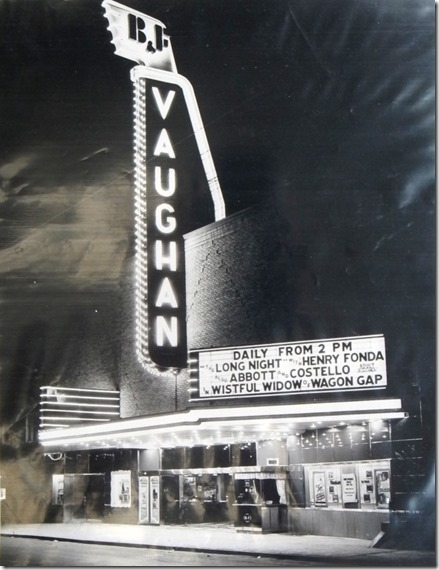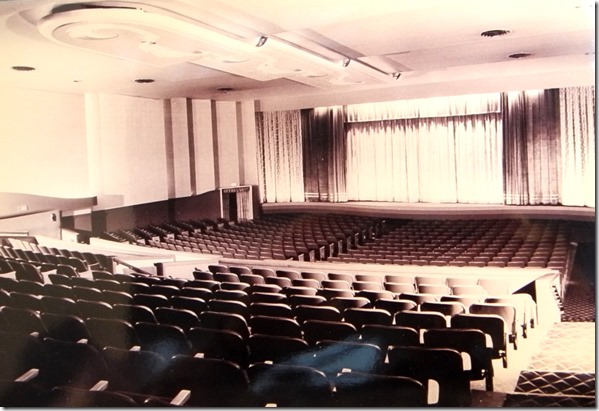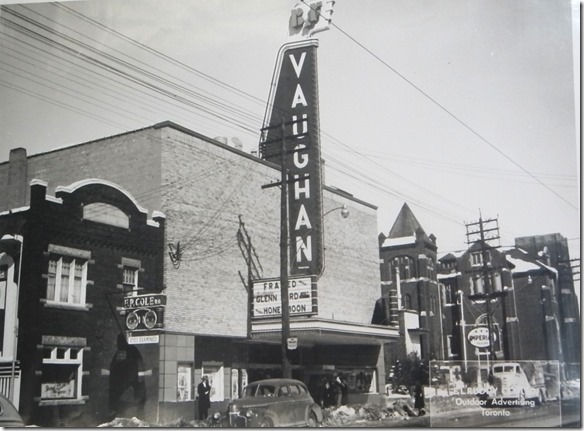The Vaughan Theatre c. 1947. Photo from the Ontario Archives, AO 2194.
When I was a young boy, the Grant and Colony Theatres were my local hangouts, in the days when my parent allowed me to attend only those theatres within walking distance of our house on Lauder Avenue. However, when I was ten years old, my parents purchased a newspaper route for me and I commenced delivering the Toronto Star to over sixty customers on our street. Papers sold for 3 cents, and I considered the profits from my business enterprise to be substantial.
A bus fare was three cents cash or four tickets for a dime. Having obtained great affluence, I pleaded with my parents for permission to travel on the bus to theatres on St. Clair Avenue West. The St. Clair Theatre I was able to walk to, but the Vaughan was too far away. With my money and parents’ permission, my first goal was to attend the Vaughan Theatre at 542 St. Clair West, a few doors west of the intersection of St. Clair and Vaughan Road.
Because I had newspapers to deliver, it was important that I return home by 5 pm. However, I must admit that after attending a matinee at the Vaughan, my customers sometimes waited longer than usual for their papers. I never explained to them why I was late, for fear that my reason might appear trivial. However, visiting the Vaughan Theatre on hot summer’s day was worth risking the wrath of my customers.
The feature of the theatre that I remember the most was its air conditioning system. It was cooler than the older theatres that I was accustomed to, as the theatre had opened in 1947 and was spanking new. The refreshing temperatures were a welcomed treat after travelling on the hot Vaughan bus. As we liked to say as kids, “It was Popsicle Cool.” In the 1940s, air conditioning was only available at Eaton’s, Simpsons, movie theatres and a few wealthy homes in Forest Hill or Rosedale. I felt the cool air against my face the instant I opened one of the modern glass doors of the theatre.
After I entering the lobby, I walked down several carpeted steps to the candy bar, situated in front of me, along the north wall. To enter the auditorium I walked up one of the gently sloped ramps on the east and west sides of the lobby. The auditorium contained almost a thousand seats, arranged in rows in the “stadium seating” style, as it is referred to today. Designs on the walls and ceiling contained simple vertical line. Generous layers of drapery surrounded the screen, creating a luxurious appearance, especially when the curtains swept open at the beginning of a film.
I attended the Vaughan Theatre often, until our family relocated to the west end of the city in 1953. The theatre eventually closed and was demolished in the 1980s. Today, the site contains some undistinguished buildings that add nothing to the streetscape.
As a kid I had no interest in the history of the theatre, but recently, when researching the theatre, I learned that plans for the Vaughan were approved by the city in May 1946, and the pouring of the concrete commenced in October the same year. The theatre opened on November 27, 1947. The architects, Kaplan and Sprachman, designed a modern yellow-brick structure with a sign above the marquee that soared high into the air, the letters B&F at its pinnacle. B&F was the name of the company that managed the theatre. This company was formed in 1921, when Samuel Fine and Samuel Bloom formed a partnership. They eventually operated 21 theatres. In 1927, the company became a subsidiary of Famous Players Corporation. B&F pioneered the ideas of screening double-bill (two movies) shows for a single admission price. This allowed smaller theatres to compete with the larger downtown theatres that showed recent releases. In 1923, they featured this concept for first time at the Christie Theatre on St. Clair, near Wychwood Avenue. B&F also pioneered the idea of midnight showings to attract the late-night crowds.
I remember the Vaughan as an exceptionally attractive structure. When it closed and was demolished, I felt that the city lost an important part of its theatrical heritage.
Location of the Vaughan Theatre at 542 St. Clair West.
Interior of the Vaughan Theatre, Photo from the City of Toronto Archives, the Mandel Collection.
Lobby and candy bar of the Vaughan Theatre, City of Toronto Archives, Series 881 File 350
The Vaughan Theatre in 1947, the film :”Framed” with Glenn Ford on the marquee. City of Toronto Archives, Series 488 File7340.
To view the Home Page for this blog: https://tayloronhistory.com/
To view previous blogs about movie houses of Toronto—historic and modern
Recent publication entitled “Toronto’s Theatres and the Golden Age of the Silver Screen,” by the author of this blog. The publication explores 50 of Toronto’s old theatres and contains over 80 archival photographs of the facades, marquees and interiors of the theatres. It relates anecdotes and stories of the author and others who experienced these grand old movie houses.
To place an order for this book:
Book also available in Chapter/Indigo, the Bell Lightbox Book Store and by phoning University of Toronto Press, Distribution: 416-667-7791
Theatres Included in the Book:
Chapter One – The Early Years—Nickelodeons and the First Theatres in Toronto
Theatorium (Red Mill) Theatre—Toronto’s First Movie Experience and First Permanent Movie Theatre, Auditorium (Avenue, PIckford), Colonial Theatre (the Bay), the Photodome, Revue Theatre, Picture Palace (Royal George), Big Nickel (National, Rio), Madison Theatre (Midtown, Capri, Eden, Bloor Cinema, Bloor Street Hot Docs), Theatre Without a Name (Pastime, Prince Edward, Fox)
Chapter Two – The Great Movie Palaces – The End of the Nickelodeons
Loew’s Yonge Street (Elgin/Winter Garden), Shea’s Hippodrome, The Allen (Tivoli), Pantages (Imperial, Imperial Six, Ed Mirvish), Loew’s Uptown
Chapter Three – Smaller Theatres in the pre-1920s and 1920s
Oakwood, Broadway, Carlton on Parliament Street, Victory on Yonge Street (Embassy, Astor, Showcase, Federal, New Yorker, Panasonic), Allan’s Danforth (Century, Titania, Music Hall), Parkdale, Alhambra (Baronet, Eve), St. Clair, Standard (Strand, Victory, Golden Harvest), Palace, Bedford (Park), Hudson (Mount Pleasant), Belsize (Crest, Regent), Runnymede
Chapter Four – Theatres During the 1930s, the Great Depression
Grant ,Hollywood, Oriole (Cinema, International Cinema), Eglinton, Casino, Radio City, Paramount, Scarboro, Paradise (Eve’s Paradise), State (Bloordale), Colony, Bellevue (Lux, Elektra, Lido), Kingsway, Pylon (Royal, Golden Princess), Metro
Chapter Five – Theatres in the 1940s – The Second World War and the Post-War Years
University, Odeon Fairlawn, Vaughan, Odeon Danforth, Glendale, Odeon Hyland, Nortown, Willow, Downtown, Odeon Carlton, Donlands, Biltmore, Odeon Humber, Town Cinema
Chapter Six – The 1950s Theatres
Savoy (Coronet), Westwood
Chapter Seven – Cineplex and Multi-screen Complexes
Cineplex Eaton Centre, Cineplex Odeon Varsity, Scotiabank Cineplex, Dundas Square Cineplex, The Bell Lightbox (TIFF)




![cid_E474E4F9-11FC-42C9-AAAD-1B66D852[1] cid_E474E4F9-11FC-42C9-AAAD-1B66D852[1]](https://tayloronhistory.com/wp-content/uploads/2015/02/cid_e474e4f9-11fc-42c9-aaad-1b66d8521_thumb1.jpg)

Wow! Just came across your article on the history of the Vaughan Theatre. Have so many memories of the theatre. It was art deco inspired and a beautiful building. Spent many Saturday afternoons there. Years later I took my nephews to magic shows there, but it eventually shut down. My grandfather built a few houses on Vaughan Road and surrounding area and I grew up on Vaughan Road, Thanks for the pictures.